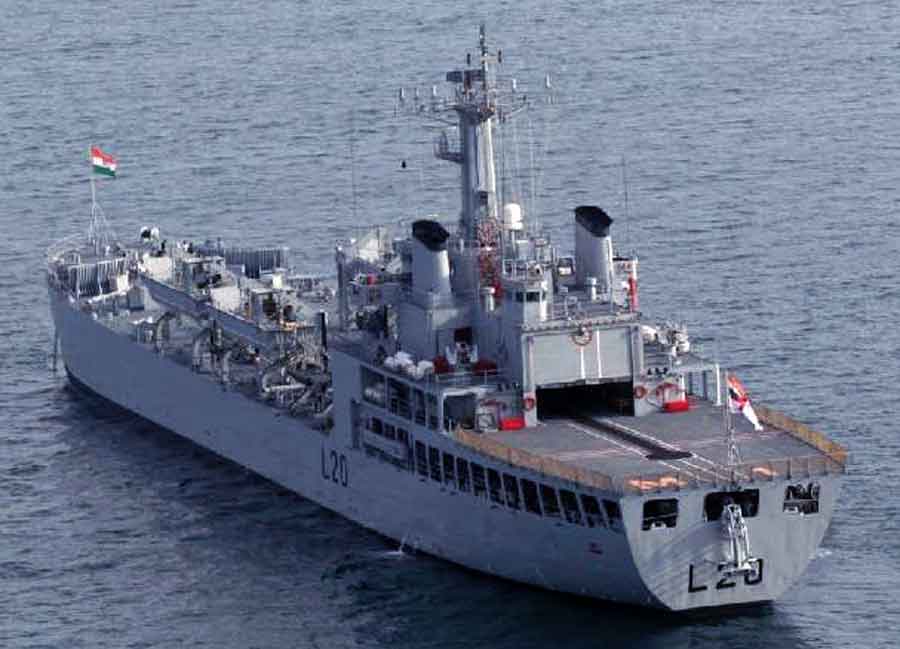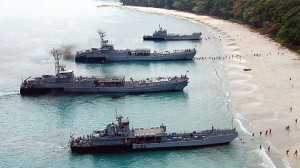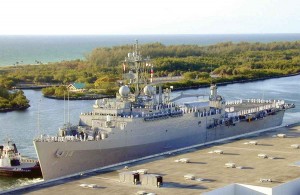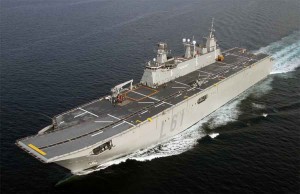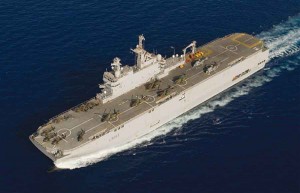Over the last four decades, the main factors influencing amphibious operations have altered, and these have had a bearing on the design of amphibious ships. In particular, the capability of shore-based coastal defence has increased by several magnitudes. Consequently, frontal amphibious assaults against well-defended positions, of the type executed during WW II, would, in all probability, not be contemplated in view of the likelihood of high casualties. Whatever be the objective, certain common conditions would need to be ensured for the success of the operation, and the design of modern amphibious ships has been driven by the need to meet these conditions.
Amphibious operations continue to retain their centrality in military plans…
Amphibious operations have often shaped the destiny of nations down the ages; from the mythological Trojan War to the conflicts among the ancient Mediterranean states, the Viking raids across the North Sea to the campaigns in the Pacific and the Normandy landings of WW II, the Korean war to more recently, the Falkland operations, the outcome of many a conflict has been determined by amphibious operations. During the Cold War, both, NATO and the Warsaw Pact alliances maintained amphibious assets. In the present day, modernisation and expansion of amphibious forces is being taken up by several navies, aimed at expanding and sustaining expeditionary power projection capability, and also for the humanitarian role of disaster relief.
Amphibious operations continue to retain their centrality in military plans and amphibious forces remain a potent and effective means of power projection. The size and lift capacity of amphibious warfare ships built in the post Cold War era , as well as their overall capability has markedly increased. Amphibious forces can be positioned, in advance, in international waters, within easy reach of the envisaged area of operation, and be in a position to execute assigned tasks at short notice. The very existence of amphibious forces constitutes a ‘threat in being’ for the opposition, and even if not committed, do exert a marked constraint on the freedom of action of the latter and their presence could bring about a favourable outcome even before the outbreak of hostilities.
The Indian Navy appreciated the significance of amphibious warfare, and maintained a capability in this field right from its infancy, with an ex-British LST “Magar”. In the 1970s, an indigenously built Landing Ship Tank – (Large) or LST (L) of the same name, displacing 5,400 tonnes, was commissioned, and to-date, five ships of this class including ‘follow-on’ improved versions, have been indigenously built and are in service. Further, from the late 1960s onwards eight smaller Landing Ship Tank – (Medium) or LST (M) of the Polish built “Polnochny” class, the latter batch displacing about 1,150 tonnes, were acquired in two tranches. Of these, the latter four remain in commission, (with their propulsion plants replaced with indigenous machinery). In addition, nine Landing Craft Utility (LCUs) displacing about 500 tonnes were indigenously constructed of which six remain in commission. Eight improved LCUs are presently under construction at an Indian shipyard.
Recognising the need to augment its amphibious capability in the developing geopolitical environment in the Indian Ocean Region, in 2007 the Indian Navy acquired its first Landing Platform Dock (LPD) the INS Jalashwa (ex USS Trenton) and stepped into the big league. Displacing about 16,600 tonnes, with a top speed of about 21 knots, this acquisition resulted in a quantum increase in the Indian Navy’s amphibious capability. In November 2013, the Indian Navy issued an RFP, inviting bids from shortlisted private sector Indian shipyards for construction of two LPDs, in technical collaboration with approved foreign shipbuilders/designers. The RFP also indicates that a further two identical LPDs would be built by the government (Ministry of Defence) owned Hindustan Shipyard Ltd., Visakhapatnam. These ships would provide the Indian Navy a potent power projection capability.
The Indian Navy appreciated the significance of amphibious warfare, and maintained a capability in this field right from its infancy…
Over the last four decades, the main factors influencing amphibious operations have altered, and these have had a bearing on the design of amphibious ships. In particular, the capability of shore-based coastal defence has increased by several magnitudes. Consequently, frontal amphibious assaults against well-defended positions, of the type executed during WW II, would, in all probability, not be contemplated in view of the likelihood of high casualties. Even if an undefended or lightly defended coastal objective is selected, the defenders would be able to redeploy forces from other positions fairly quickly, using modern means of military mobility, to thwart the landing force from achieving its objective. Therefore, the amphibious operation needs to be conducted by ensuring favourable terms of engagement for the landing force. This firstly requires careful defining of the objective. For example, whether the aim is to establish a base for further major land operations in the hinterland or at the other end of the scale whether a ‘raid’ for a limited aim such as destroying specific assets, or rescuing/recovering personnel, or feint to divert the enemy’s attention, is intended. Whatever be the objective, certain common conditions would need to be ensured for the success of the operation, and the design of modern amphibious ships has been driven by the need to meet these conditions.
Firstly, an element of surprise is essential. The force should, therefore, arrive off its objective undetected. A high transit speed is required as it would allow the amphibious force to arrive at its objective from considerable distance, under cover of darkness, thus reducing the probability of it being detected or its destination being ascertained. The main force would normally position itself ‘over the horizon’ from its shore objective, in order to remain unobservable from the shore as long as the situation so requires.
A substantial integral aviation lift capability is a de rigeur design requirement for present day amphibious ships…
Secondly, having arrived at the objective, the land force needs to be rapidly concentrated ashore, at the beachhead or at the inland objective in order to commence its operations straightaway, before the defenders can react. Also, capability to rapidly evacuate/re-embark the land force on completion of the operation, or as required by the tactical situation, is essential. Presently, helicopters provide the most rapid means of disembarkation from the amphibious ship and transit to and from the landing location. They allow troops to be rapidly disembarked at inland objectives, well away from the shoreline, while the ship is stationed ‘over the horizon’. A substantial integral aviation lift capability is a de rigeur design requirement for present day amphibious ships. Depending on the requirements and the budget, the aviation capability could include integral airborne strike and close air support capability, generally by STOVL aircraft. The design of the ship would, therefore, need to provide the full range of operational and maintenance facilities for integral aviation. The latter is weight and volume intensive.
While helicopters provide the most rapid means of disembarkation, they do have payload limitations. The amphibious operation could well require rapid deployment of armour (MBTs, light tanks and APCs) and artillery elements, requiring amphibious ships to be provided with appropriate ‘ship-shore connecters’, (landing craft) which need to combine high payload with high transit speed, rapid loading and unloading capability, as well as good sea-keeping ability, so that the throughput in terms of ‘shuttles per day’ can be maximized. For operation of such craft, amphibious ships require to incorporate a floodable “well dock” in the stern part of the ship. The landing craft are stored in the dock and enter and leave the dock through a “stern gate” located at the transom. Smaller landing craft are also provided, as specified, stowed on davits or in side recesses and these can be launched and recovered with suitable launching /recovery systems, without the need for docking/undocking operations.
In order to be capable of meeting the requirements of the entire spectrum of operations, amphibious warfare ships need to be capable of carrying the full range of equipments and stores that could be required by the embarked force to meet any contingency. The stowage arrangements need to facilitate disembarkation of only those equipments required for a particular operation, without the need for shifting/unloading other equipment, not required for the immediate task. Movement routes, therefore, need to be incorporated in the design of the ships, to facilitate easy and rapid movement of embarked force personnel and their equipment from their living/storage areas to points of disembarkation on the helo/flight deck and well deck. For this, lifts, ramps, ladders and walkways need to be provided, along with handling equipment for stores, such as monorails, gantry cranes and conveyers. Flexibility of utilising aircraft hangars for stowing additional vehicles as required by the situation also needs to be ensured.
Accommodation requirements of the embarked force, air wing and ship’s crew also need to be met. The standard of accommodation needs to be suitable for enabling prolonged occupation, as the ship could be deployed at sea for considerable duration. The space required for accommodation, stores and equipment of the personnel is, therefore, appreciable. In addition, extensive medical facilities analogous to a fully equipped hospital and (joint) C4I facilities to allow the ship to operate as a Command Platform need to be provided.
Accommodation requirements of the embarked force, air wing and ship’s crew also need to be met…
Provision of the above-mentioned capabilities, especially the weight and volume intensive facilities for housing and maintaining the integral aviation wing, have resulted in a marked increase in the size and cost of present day amphibious ships as compared to their slow, flat-bottomed forbears of yesteryear. Although, traditional flat bottomed landing ships are still in commission in a number of navies, they have little utility for intensive amphibious operations envisaged in the present day, due to their low speed and limited aviation capability. However, they remain effective for low intensity amphibious operations and for disaster relief.
Current day amphibious warfare ships are generally of two types, the larger ones, with greater aviation capability are configured with aircraft carrier type flat upper decks, with island superstructures on the starboard side and are normally termed as Landing Ship, Helicopter Dock (LHDs). This allows a greater number of helicopter ‘spots’ to be provided and, depending on the size of the ship, also enables the operation of STOVL fixed-wing aircraft, for which a ‘ski-jump’ could be provided to increase the effectiveness of fixed-wing strike aircraft. The aircraft hanger is normally located on the second deck, below the flight deck. Smaller vessels have a centralised superstructure forward, with a large helo deck aft, with the hangar generally being located forward of the helo deck, at the same level are normally termed as Landing Platform Dock (LPDs). Speed, size and sea keeping requirements mandate a conventional mono-hull design, which would not be required to be capable of directly beaching but would be required to have full capability for rapidly landing the embarked force and its equipment from a stand-off position over the horizon out of visual contact from the shore.




